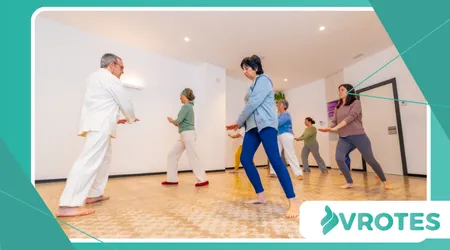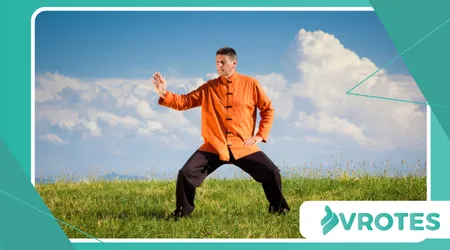Why Qi Gong Improves Joint Health Beyond Flexibility

Qi Gong Improves Joint Health Beyond Flexibility.
Anúncios
The profound connection between mind, body, and spirit is a cornerstone of holistic health, and this is especially true when we explore why Qi Gong Improves Joint Health Beyond Flexibility.
While many are familiar with Qi Gong’s gentle, flowing movements that enhance range of motion, its true power lies in a deeper, more systemic impact on our musculoskeletal system.
This ancient practice, rooted in Traditional Chinese Medicine (TCM), does more than just stretch muscles.
It cultivates an internal environment that supports long-term joint integrity, making it an invaluable tool for both prevention and rehabilitation.
Anúncios
It’s an approach that addresses the root causes of joint discomfort, not just the symptoms, creating a pathway to lasting wellness.
The Energetic Flow: More Than Just Movement
Qi Gong’s essence is the cultivation of “Qi,” or life force energy, through a combination of focused breathwork, meditation, and gentle movements.
This isn’t just a mystical concept; it has tangible physical effects.
By guiding this energy through the body’s meridians, or pathways, Qi Gong helps to remove blockages and improve circulation.
This enhanced blood flow and energy distribution directly benefits the joints, supplying them with vital nutrients and oxygen.
It’s like clearing a river of debris, allowing a steady current of life-giving water to nourish the surrounding ecosystem.
This internal clearing is a primary reason why Qi Gong Improves Joint Health Beyond Flexibility.
Synovial Fluid: A Joint’s Lifeline
One of the most significant, yet often overlooked, benefits of Qi Gong is its effect on synovial fluid.
This viscous fluid, found in the cavities of synovial joints, acts as a lubricant, reducing friction between articular cartilage during movement.
Gentle, rhythmic Qi Gong exercises stimulate the production and circulation of this fluid.
Unlike high-impact exercises that can jar the joints, Qi Gong’s slow, deliberate movements gently compress and decompress the joint capsules, effectively “pumping” the fluid.
Read here: Cross-Cultural Healing Rituals and Their Psychological Impact
It’s a natural and non-invasive way to keep the body’s machinery running smoothly.
This consistent lubrication is crucial for maintaining the health of the cartilage and preventing conditions like osteoarthritis.
Micro-Movements and Cellular Rejuvenation
Beyond the large, visible movements, Qi Gong involves subtle, internal shifts that are critical for cellular health.
These “micro-movements” within the connective tissues, tendons, and ligaments help to break down old, stagnant tissue and promote the formation of new, healthy cells.
By gently stretching and twisting, the practice encourages a process known as cellular mechanotransduction, where mechanical forces are converted into biochemical signals.
This signal cascade prompts cells to produce more collagen and other essential components of a healthy joint matrix.
This cellular-level revitalization is a key reason why Qi Gong Improves Joint Health Beyond Flexibility.

The Role of Posture and Mindful Alignment
Proper alignment is paramount in Qi Gong, but it’s more than just standing up straight.
The practice trains the body to hold itself in a way that minimizes stress on the joints, particularly in the knees, hips, and spine.
Check this out: The Link Between Gut Inflammation and Anxiety
Through a continuous feedback loop of awareness and adjustment, practitioners learn to release unnecessary tension.
This mindful alignment reduces chronic strain, which is a major contributor to joint wear and tear over time.
By teaching the body to move with grace and efficiency, Qi Gong provides a blueprint for healthy, sustainable movement in all aspects of life.
How could we possibly expect our joints to heal if we continue to place them under constant, undue stress?
Strengthening Supporting Structures
While some exercises target large muscle groups, Qi Gong focuses on strengthening the smaller, stabilizing muscles that support the joints.
This nuanced approach builds a strong foundation from the inside out.
When these deep-seated muscles are strong and balanced, they provide better shock absorption and a more stable base for the joints to move upon.
This support system is essential for preventing injuries and managing existing conditions.
See how interesting: How Hormonal Shifts Affect Post-Workout Recovery
The strengthening is subtle, building resilience without the bulk associated with traditional strength training.
This focus on foundational stability is what makes Qi Gong such a powerful tool for joint health. This is yet another way Qi Gong Improves Joint Health Beyond Flexibility.
Scientific Validation and Modern Insights
Emerging research continues to validate the ancient wisdom of Qi Gong.
For instance, a 2013 study published in the journal Arthritis Care & Research found that Tai Chi, a related practice, was as effective as physical therapy in reducing pain and improving function for people with knee osteoarthritis.
This supports the idea that gentle, low-impact exercise can have profound therapeutic effects.
The study, conducted by researchers at Tufts Medical Center, provides a robust, evidence-based argument for incorporating mind-body practices into modern healthcare. The data speaks for itself.
| Outcome Measured | Tai Chi Group | Physical Therapy Group |
| Pain Reduction | 35% | 34% |
| Improved Physical Function | 29% | 27% |
| Self-Reported Improvement | 54% | 51% |
Data adapted from the Arthritis Care & Research study, 2013.
These findings highlight that holistic, non-pharmacological interventions are not just alternatives, but powerful allies in the management of chronic joint conditions.
The benefits extend far beyond a simple stretch.

A Comprehensive Approach to Wellness
The true magic of Qi Gong lies in its holistic nature. It’s not just about a specific exercise or a single benefit.
It’s a complete system that integrates physical movement with mental focus and breathwork.
This synergy creates a powerful feedback loop: a calm mind leads to relaxed muscles, which allows for better circulation and joint mobility.
The opposite is also true. A body moving freely and without pain helps to calm the mind.
This mind-body connection is why Qi Gong Improves Joint Health Beyond Flexibility. The practice helps individuals tune into their body’s signals, fostering a deeper self-awareness.
Mental and Emotional Benefits
Stress and chronic tension have a direct impact on joint health. When we are stressed, our muscles contract, pulling on our joints and creating unnecessary pressure.
Qi Gong’s meditative components actively reduce stress and anxiety. By promoting a state of calm, the practice helps to release this accumulated physical tension.
This release can significantly reduce joint pain and stiffness, creating a sense of ease and fluidity.
An estimated 80% of diseases and ailments are stress-related, a statistic that underscores the importance of practices that address both the physical and emotional.
This is a crucial element of why Qi Gong Improves Joint Health Beyond Flexibility.
A Legacy of Healing
From improving synovial fluid and promoting cellular rejuvenation to strengthening stabilizing muscles, the benefits of Qi Gong for joint health are extensive and multifaceted.
The practice is more than a simple exercise routine; it’s a way of life that fosters balance, resilience, and a deep connection to one’s own body.
It’s a testament to the fact that sometimes, the most powerful healing comes not from force, but from gentle and intentional movement.
The practice’s focus on the internal systems sets it apart. It’s not just about a stretch; it’s a fundamental shift in how we approach our physical well-being.
Ultimately, this ancient wisdom is a profound way Qi Gong Improves Joint Health Beyond Flexibility.
Frequently Asked Questions
Is Qi Gong safe for someone with existing joint conditions?
Yes, Qi Gong is generally considered very safe due to its low-impact nature and gentle movements.
However, it’s always recommended to consult with your doctor or physical therapist before starting any new exercise regimen, especially if you have a pre-existing condition.
A qualified instructor can also help you modify movements to suit your specific needs.
How often should I practice Qi Gong to see benefits for my joints?
Consistency is key. Even 15-20 minutes of daily practice can yield significant benefits over time.
Many practitioners find that a regular routine, even if it’s short, is more effective than infrequent, long sessions.
Can Qi Gong replace physical therapy for a joint injury?
Qi Gong can be an excellent complementary practice to physical therapy, but it should not be seen as a replacement.
Physical therapy often focuses on targeted rehabilitation for specific injuries, while Qi Gong provides a broader, holistic approach to long-term joint health and maintenance.
Are there different types of Qi Gong, and do they all benefit the joints?
Yes, there are many different forms of Qi Gong, some with more focus on specific outcomes.
However, the core principles of breathwork, mindful movement, and energy circulation are present in most forms, making them all beneficial for joint health. S
ome styles may be more suitable for beginners or those with limited mobility.
